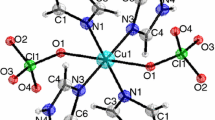Abstract
Simultaneous TG-DTG-DTA studies under non-isothermal conditions on [Co(NH3)6]Cl3, [Co(NH3)5]Cl2 and [Co(NH3)]2(C2O4)3.4H2O complexes have been carried out in air and argon atmospheres in the temperature range 293–1273 K. All the dissociation processes occur in three main stages. The kinetics of thermal decomposition of the complexes have been evaluated from the dynamic weight loss data, to determine the most probably mechanisms of the stages on the basis of statistical analysis. The decomposition of the compounds was controlled by diffusion and phase boundary reactions except stage III of the oxalate complex in argon (random nucleation). The activation energiesE a of the particular stages of the thermal decomposition were calculated.
Zusammenfassung
Simultane TG-DTG-DTA-Untersuchungen an den Komplexverbindungen [Co(NH3)6]Cl3, [Co(NH3)5Cl]Cl2 und [Co(NH3)6]2(C2O4)3.4H2O unter nichtisothermen Bedingungen wurden in Luft und Argonatmosphäre bei 293–1273 K durchgeführt. Die Zersetzung läuft in jeweils drei Stufen ab. Für die kinetische Auswertung der thermischen Zersetzung der Komplexverbindungen aus den dynamischen Gewichtsabnahmekurven wurde der wahrscheinlichste Mechanismus der einzelnen Stufen mit Hilfe von statistischen Analysen ermittelt. Die Zersetzung der Komplexverbindungen wird meist durch Diffusions- und Phasengrenzreaktionen kontrolliert, nur bei der 3. Stufe des Oxalatkomplexes in Argon herrscht statistische Keimbildung. Die AktivierungsenergienE a der einzelnen Zersetzungsstufen werden berechnet.
Резюме
В атмосфере воздуха и аргона проведены в интервале температу р 293–1273 К неизотермические со вмещенные ТГ—ДТГ и ДТ А исследования компле ксов [Co(NH3)6]Cl3, [Co(NH3)5Cl]G2 и [Co(NH3)6]2(C2O4)3.4H2O. Все проц ессы диссоциации протека ют в три стадии. Исходя из данн ых динамической поте ри веса, проведена оценка кин етика термического разложения и на основ ании статистическог о анализа определен наиболее в озможный механизм реакционных стадий. Р азложение определяе тся диффузионным механи змом и механизмом поверхности раздела фаз, за исключением ст адии III реакции разложения о ксалатного комплекса в аргоне, по дчиняющейся механиз му произвольного образ ования центров крист аллизации. Вычислены энергии ак тивации Еa отдельных стадий разложения.
Similar content being viewed by others
References
W. W. Wendlandt and J. P. Smith, The Thermal Properties of Transition — Metal Ammine Complexes, Elsevier, Amsterdam 1967, p. 37.
Inorg. Synt., 2 (1946) 217.
Ibid., 9 (1977) 160.
Ibid., 2 (1946) 220.
E. Ingier-Stocka, in preparation to press.
A. B. Phadnis and V. V. Deshpande, Thermochim. Acta, 62 (1983) 361.
J. M. Criado, J. Morales and V. Rives, J. Thermal Anal., 14 (1978) 221.
Author information
Authors and Affiliations
Rights and permissions
About this article
Cite this article
Ingier-Stocka, E. Thermal decomposition reactions of amminecobalt(III)complexes. Journal of Thermal Analysis 33, 487–493 (1988). https://doi.org/10.1007/BF01913927
Issue Date:
DOI: https://doi.org/10.1007/BF01913927




